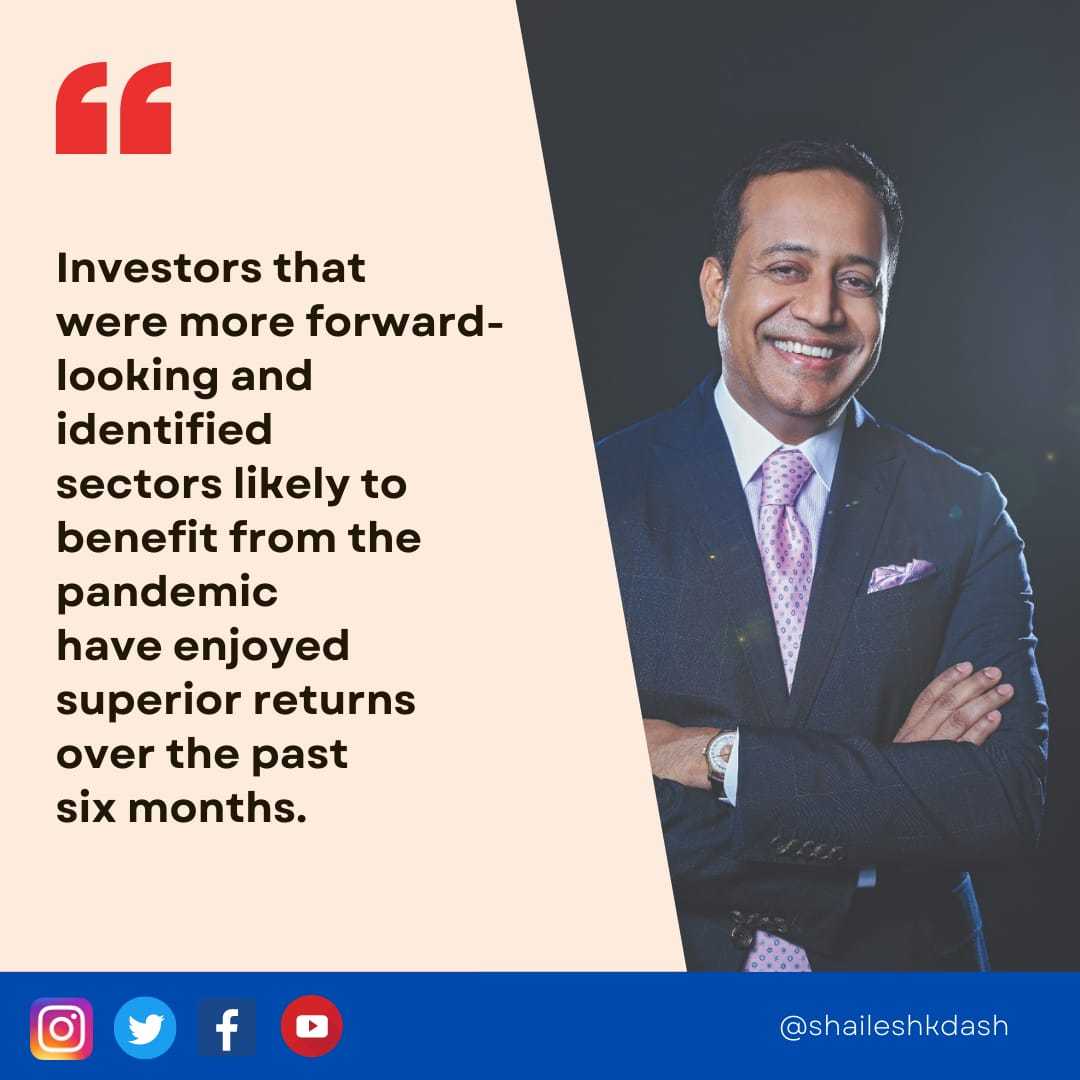Investors that identified sectors likely to benefit from the pandemic have enjoyed superior returns, writes entrepreneur and investor Shailesh Dash, who shares his perspective in this monthly column
The US stock markets continue their upward journey with the S&P 500 recording the seventh straight month of gains in August 2021. So far this year, the index has touched 53 new all-time highs, 12 of which occurred in August – all of this despite rising inflation and the fear of a fourth wave of Covid-19 led by the delta variant. The exponential rise in the equity markets since the March 2020 crash was largely backed by the Fed through a series of accommodative policies, including the stimulus cheques and
bond purchasing programmes. This, in turn, led to increased liquidity in the markets, which pumped the upswing to newer highs. The increased emphasis on vaccination since November 2020 has also pushed the economy towards a stronger than expected recovery. This has now put the US on track to record its strongest ever year in the past 40 years, with its GDP forecast to grow anywhere in the range of 6 – 10 per cent in 2021.
This widespread recovery is reflected in the S&P 500 corporate earnings for Q2 2021, which smashed all estimates to record the highest year-on-year growth since 2009. While one can argue that these are compared to the dismal earnings posted in pandemic-ridden 2020, it still talks a lot about the resilience shown by high-quality companies that have managed their balance sheets and cashflows efficiently to remain profitable. Investors that were more forward-looking and identified sectors likely to benefit from the pandemic have enjoyed superior returns over the past six months. Amongst the most profound were
technology-based solutions that enjoyed tailwinds from a boost to earnings during the pandemic. They helped propel sectors such as e-commerce, fintech, cloud computing, healthtech and medtech, as well as online gaming and streaming to emerge as game changers. Stocks within these verticals witnessed continued buoyancy, supported by strong fundamentals, proven resilience and attractive growth prospects. On the other hand, investors have been less fearful of the defaults coming in from the companies anytime soon – this is evident in the narrow credit spreads in the bond market. We can also take a look at some of the macroeconomic indicators to broadly understand the investor sentiment – the unemployment rate dipped in August to 5.2 per cent from 5.4 per cent in July, while the hourly earnings increased by 4.3 per cent from August 2020. Few reports also suggest the proportion of jobs to job-seeking people being higher, largely indicative of the robust economic strength and outlook of the companies going forward. Nevertheless, several pandemic-induced external factors are likely to cause some vulnerability, possibly slowing down the rate of economic recovery in the near term. The
rising number of Covid-19 cases owing to the new delta variant and steepening inflation have added fuel to the concerns of investors. The tapering of the Fed’s $120bn a month bond purchasing programme in the coming months is also causing some worry for the retail investors fearing that the liquidity would dry up. From the Fed point of view, several measures have been taken to remain transparent and maintain an optimistic investor sentiment so as to avoid any shocks to the stock market, as it works towards ensuring a smooth economic recovery. The Fed believes the rising inflation is only a part of the transitory phase
caused by the combination of supercharged demand (from federal stimulus) and disrupted supply (bottlenecks and pandemic impact), and will be short lived. As the demand moderates and the supply chains recover, core inflation is likely to come closer to the Fed’s target.
Undoubtedly, global economies are heading into a full recovery from Covid-19. On the macro
front, the US economy is likely to remain in a state of recovery as reopening of businesses continue, supported by government spending, an increase in personal consumption, coupled with fixed residential and non-residential investments. However, investors must be prepared for higher uncertainty in equity markets.
In the near term, investors should shift their focus back to the company fundamentals and
not rely solely on liquidity-driven opportunities or the easy early-cycle investment opportunities that have already been acknowledged and exploited – especially given that some episodes of corrections are inevitable amid what the market calls as an expensive valuation. According to BlackRock, investors largely
avoided or sold quality stocks in favour of riskier bets that paid off in the early phases of the market upswing. This has now put the higherquality stocks at their largest discount to the broader market since the dot-com bubble of the early 2000s. Hence it is necessary for investors to cut out the noise caused by the short-term shocks and focus on long-term bets. Investors are advised to be prudent and maintain clear long-term objectives that are likely to reap strong benefits.
https://shaileshdashdotcom.wordpress.com/2021/10/10/us-equity-marketswhat-to-expect-going-forward/

Comments